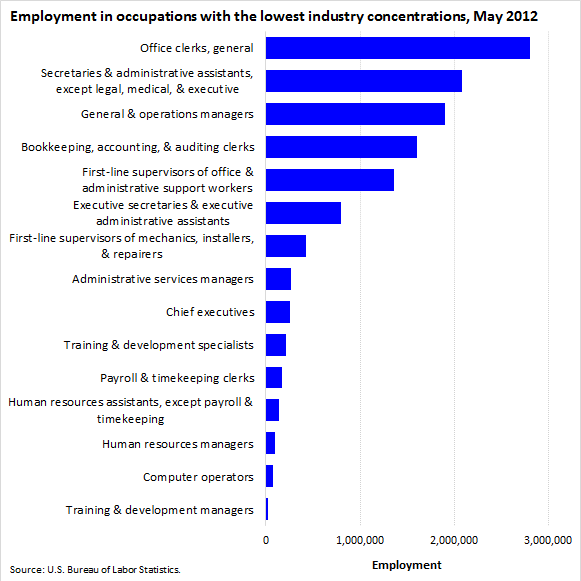An official website of the United States government
 United States Department of Labor
United States Department of Labor
Some occupations are found in nearly every industry in the United States, while others are specific to one or only a few industries. The Herfindahl-Hirschman index (HHI) can be used to provide a measure of occupational concentration by industry.

| Occupation | Employment | Herfindahl-Hirschman index |
|---|---|---|
Office clerks, general | 2,808,100 | 791 |
Secretaries and administrative assistants, except legal, medical, and executive | 2,085,680 | 913 |
General and operations managers | 1,899,460 | 715 |
Bookkeeping, accounting, and auditing clerks | 1,606,260 | 725 |
First-line supervisors of office and administrative support workers | 1,359,150 | 937 |
Executive secretaries and executive administrative assistants | 803,040 | 919 |
First-line supervisors of mechanics, installers, and repairers | 421,650 | 855 |
Administrative services managers | 264,090 | 911 |
Chief executives | 255,940 | 764 |
Training and development specialists | 217,930 | 905 |
Payroll and timekeeping clerks | 172,740 | 802 |
Human resources assistants, except payroll and timekeeping | 139,200 | 985 |
Human resources managers | 98,020 | 970 |
Computer operators | 71,560 | 942 |
Training and development managers | 27,350 | 948 |
NOTE: Industry concentration, which is not shown on the chart, is measured by the Herfindahl-Hirschman index (HHI), calculated by industry sector. A higher HHI indicates that the occupation was found primarily in a few industries, whereas a lower value indicates that the occupation was spread more evenly across industries.
| ||
Occupations that were spread most evenly across industry sectors, as measured by low HHIs, included two management occupations with broad job duties: chief executives and general and operations managers, with employment of 255,940 and 1,899,460, respectively in May 2012.
Most of the remaining occupations with low HHIs were related to general office administration or human resources.
Occupations associated with general office administration included general office clerks; secretaries and administrative assistants, except legal, medical, and executive; bookkeeping, accounting, and auditing clerks, and first-line supervisors of office and administrative support workers. Well over 1 million workers were employed in each of these occupations in May 2012.
Human resources occupations with low industry concentrations ranged from the managerial level through the clerical level, and included human resources managers; training and development managers; training and development specialists; human resources assistants, except payroll and timekeeping; and payroll and timekeeping clerks.
Occupations with low industry concentrations may allow more mobility for jobseekers as they look for jobs in various industries and geographical areas.
These data are from the Occupational Employment Statistics program. To learn more, see "Measuring occupational concentration by industry," by Audrey Watson, Beyond the Numbers, February 2014.
Bureau of Labor Statistics, U.S. Department of Labor, The Economics Daily, The Herfindahl-Hirschman index and occupational concentration by industry at https://www.bls.gov/opub/ted/2014/ted_20140305.htm (visited October 25, 2025).

